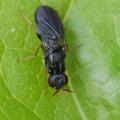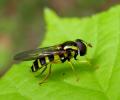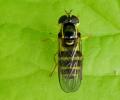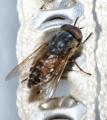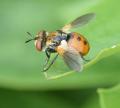Page 1 of 2: 12
|
|
small non-Bibionid (?)
|
|
| Sundew |
Posted on 19-10-2007 14:19
|
|
Member Location: Posts: 3890 Joined: 28.07.07 |
Hi, Cars are the worst Diptera killers, they wipe out whole swarms of tiny flies. I picked one that was already clinically dead and put it under the stereo microscope. It appeared to be a black Bibionid (?) with hairy wings and blonde hairs on the thorax. Is there any more identification possible? Thanks, Sundew The scale bar in the upper left gives mm. Edited by Sundew on 19-10-2007 16:58 |
|
|
|
| ChrisR |
Posted on 19-10-2007 14:54
|
|
Administrator Location: Posts: 7699 Joined: 12.07.04 |
Not a bibionid but maybe Scatopsidae? |
|
|
|
| Sundew |
Posted on 19-10-2007 16:44
|
|
Member Location: Posts: 3890 Joined: 28.07.07 |
Scatopsidae have different antennae. In my photos, the hairy wings and the bristles on the antennae segments recall Cecidomyiidae, but the latter have longer antennae. Are there further family suggestions? Obviously, our knowledge of the minute flies is still incomplete... Sundew |
|
|
|
| Paul Beuk |
Posted on 19-10-2007 16:53
|
|
Super Administrator Location: Posts: 19208 Joined: 11.05.04 |
Mouthparts would suggest Ceratopogonidae.
Paul - - - - Paul Beuk on https://diptera.info |
|
|
|
| Sundew |
Posted on 19-10-2007 17:25
|
|
Member Location: Posts: 3890 Joined: 28.07.07 |
In Ceratopogonidae, females with bristly antennae are also met! So I suppose Paul has supplied me with the right family - thanks! Now we know where to search further, perhaps a genus guess is possible? If not, I'll stand it... Sundew |
|
|
|
| Andre |
Posted on 19-10-2007 19:14
|
|
Member Location: Posts: 2111 Joined: 18.07.04 |
Wing venation and the really upright positions of the hairs on the antennae would lead me to Chironomidae. Male can be very hairy... what would you say Paul? Greetings  |
|
|
|
| Andre |
Posted on 19-10-2007 19:16
|
|
Member Location: Posts: 2111 Joined: 18.07.04 |
And do I see the edge of the pronotum sticking out in front of the thorax? |
|
|
|
| jorgemotalmeida |
Posted on 19-10-2007 19:38
|
|
Member Location: Posts: 9295 Joined: 05.06.06 |
Ceratopogonidae.  |
|
|
|
| jorgemotalmeida |
Posted on 19-10-2007 19:44
|
|
Member Location: Posts: 9295 Joined: 05.06.06 |
Do you have one shot of mouthparts for this fly? It would help..  |
|
|
|
| jorgemotalmeida |
Posted on 19-10-2007 19:53
|
|
Member Location: Posts: 9295 Joined: 05.06.06 |
as the M vein doesn't fork... it would give us to Chironomidae... with the mouthparts well visible we will wipe out any doubts, I hope.  |
|
|
|
| Xespok |
Posted on 19-10-2007 20:58
|
|
Member Location: Posts: 5550 Joined: 02.03.05 |
I still think this should be a Chironomid.
Gabor Keresztes Japan Wildlife Gallery Carpathian Basin Wildlife Gallery |
|
|
|
| Sundew |
Posted on 20-10-2007 00:45
|
|
Member Location: Posts: 3890 Joined: 28.07.07 |
There are no better pics from the mouth part than those below. In high magnification the depth of focus unfortunately is very low. The head is peculiar with several "appendices" beside the antennae. If the photos are not sufficient, I could try to get better ones, as I have kept the animal. However, my equipment has already reached its limits... Sundew |
|
|
|
| Tony Irwin |
Posted on 20-10-2007 09:29
|
|
Member Location: Posts: 7168 Joined: 19.11.04 |
I'd say Chironomidae - based on the postpronotal groove, prominent ante-pronotum, and the long legs which I've never seen in such a hairy ceratopogonid. While most chrionomids have greatly reduced mouthparts, there are a few exceptions, and there are no evident stylets which we might expect in a certatopogonid. And, to be less objective, - it just "feels" like a chironomid! 
Tony ---------- Tony Irwin |
|
|
|
| jorgemotalmeida |
Posted on 20-10-2007 12:21
|
|
Member Location: Posts: 9295 Joined: 05.06.06 |
Tony, I suppose that there are no chironomids with a fork in M-vein. Is it right? |
|
|
|
| Tony Irwin |
Posted on 20-10-2007 19:13
|
|
Member Location: Posts: 7168 Joined: 19.11.04 |
jorgemotalmeida wrote: Tony, I suppose that there are no chironomids with a fork in M-vein. Is it right? As far as I know, that's right. There are a very few ceratopogonids where M is unforked, but usually they do have M1 and M2, even if M2 is faint. Tony ---------- Tony Irwin |
|
|
|
| Sundew |
Posted on 20-10-2007 23:45
|
|
Member Location: Posts: 3890 Joined: 28.07.07 |
A small fly initiates a big discussion! It was very interesting for me to track your pros and cons concerning the possible families. There is a nice picture of a fossil Chironomid included in Baltic amber (http://www.fossil...idae-b.htm) that closely resembles my specimen according to overall shape, mouth parts, and hairy wings. Chironomids also use to form swarms that stick to the car front. So I second the Chironomidae party, realizing that deeper ID is impossible in this difficult family... Nevertheless many thanks to all who contributed to the discussion in this thread! You were great! (As usual.) Sundew |
|
|
|
| Tony Irwin |
Posted on 21-10-2007 14:10
|
|
Member Location: Posts: 7168 Joined: 19.11.04 |
The amber fossil is actually one of the phantom midges (Chaoboridae) - closely related to Chironomidae, but distinguished by a more complex wing venation, which is clearly seen in the picture. They are often confused (even here on Diptera.info!  ) )
Tony ---------- Tony Irwin |
|
|
|
| jorgemotalmeida |
Posted on 21-10-2007 14:23
|
|
Member Location: Posts: 9295 Joined: 05.06.06 |
Tony Irwin wrote: The amber fossil is actually one of the phantom midges (Chaoboridae) - closely related to Chironomidae, but distinguished by a more complex wing venation, which is clearly seen in the picture. They are often confused (even here on Diptera.info!  ) ) Tony I think these photo I took refers to a Chaoborus sp. >> http://www.dipter...ad_id=8305 is it right?  |
|
|
|
| Tony Irwin |
Posted on 21-10-2007 14:32
|
|
Member Location: Posts: 7168 Joined: 19.11.04 |
Yes, Jorge - Chaoboridae, though I'm not sure which species.
Tony ---------- Tony Irwin |
|
|
|
| Sundew |
Posted on 21-10-2007 15:11
|
|
Member Location: Posts: 3890 Joined: 28.07.07 |
Also Jorge's beautifully photographed animal bears a certain resemblance to mine; however, it is much bigger. In larger wings I would expect a more complex venation as a matter of stabilization. The basic pattern need not change by insertion of some more branches, I suppose. (However, my experience comes from leaf venation patterns that naturally are something completely different! Apart from differing functions, nevertheless there is one underlying idea: how can a lamina of given size get stabilized efficiently but economically?) If a more complex wing venation separates Chaoboridae from Chironomidae, my fly clearly belongs to the latter family. I could not find out the minimum size of Chaoborids, but if there are specimens that measure only a few mm I would like to know whether their wing venation is nevertheless much more complex than in my fly. Sundew |
|
|
|
Page 1 of 2: 12
| Jump to Forum: |


